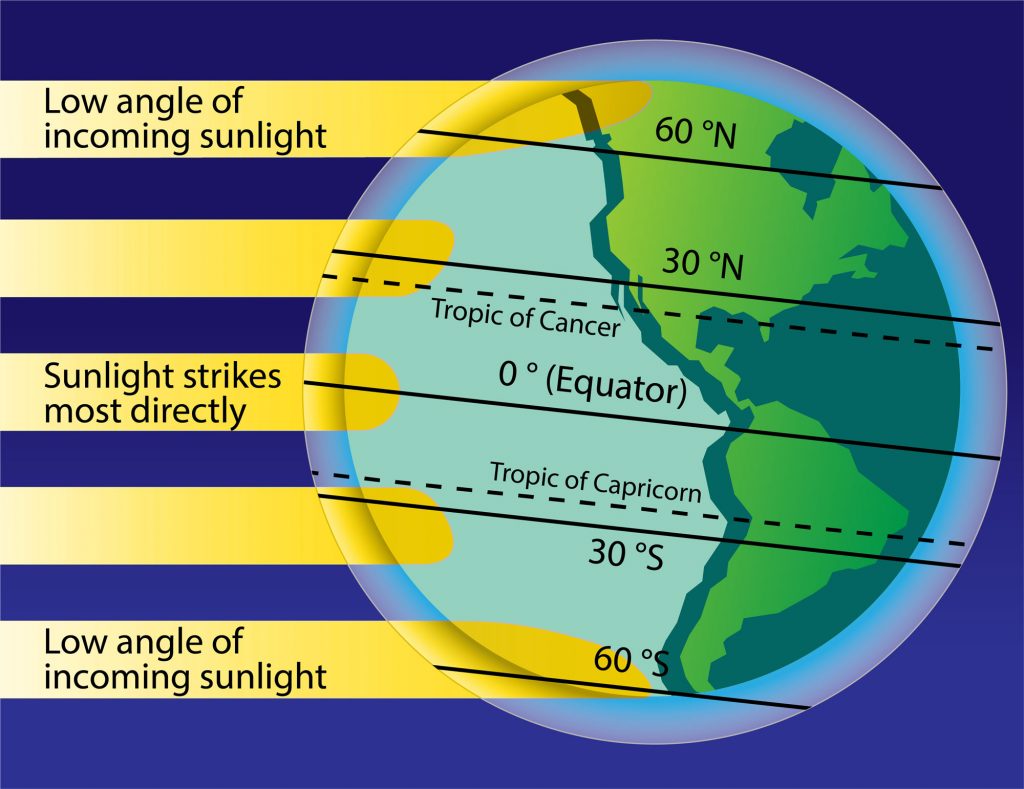In gardening sunlight falling directly on the plant is direct sunlight while indirect sunlight refers to shaded areas. See also what is an isoenzyme.

Absorption Reflection Of Sunlight Understanding Global Change
What part of the earth gets the least sunlight.
. Jan Mayen a Norwegian island is a piece of land near Greenland. This means Yuma experiences an average of 4015 hours of sunshine per year. The Sun shines most directly on the Tropic of Cancer 235 degrees north of the equator giving its most direct energy on Earth to the Northern Hemisphere.
Throughout the year different parts of Earth receive the Suns most direct rays. Sunlight rays are concentrated on smaller surface areas causing warmer temperatures and climates. This is one of the darkest places on the planet that gets only 823 hours of sunshine a year.
As you can see in question 3 South America is located in the diagram of Earth. Places in the world with the most daylight hours. And when the South Pole tilts toward the Sun its winter in the Northern Hemisphere.
Which areas receive the most direct sunlight. City of Yuma Arizona taking the. The area around the Equator receives the most direct sunlight thus absorbs the most heat.
As the sun hits the equator more directly it receives less direct sunlight at the poles so the equator receives more sunlight. Sunlight is a portion of the electromagnetic radiation given off by the Sun in particular infrared visible and ultraviolet light. Whether during the Summer or Winter months the suns daily path starts in the East swings South and then sets in the West.
During the winter solstice the Sun shines most. Places closer to the equator recieve virtually the same amount of sunlight every day of the year. In areas at the equator the angle of incoming rays from the Sun is perpendicular 90 degrees to the Earths surface during all days of the year.
As incoming rays move further away from the equator solar intensity decreases. Sunniest Places on Earth. In equatorial regions the length of days and the directness of sunlight dont change as much.
Tropic of Cancer and Tropic of Capricorn are located in the Tropic of Cancer. As incoming rays move further away from the equator solar intensity decreases. The 90-degree angle would be hotter since this is receiving the most direct sunlight concentrated in a smaller area.
The Short Answer. What part of the earth gets the Suns most direct and hottest rays. On Earth sunlight is scattered and filtered through Earths atmosphere and is obvious as daylight when the Sun is above the horizonWhen direct solar radiation is not blocked by clouds it is experienced as sunshine a combination of bright light.
Directly on the Tropic of Capricorn 235 degrees south of the equator giving its most direct energy on Earth to the Southern Hemisphere. For those of us in the Northern Hemisphere south-facing windows will receive the most direct sunlight throughout the day. During the year the equator receives the most direct sunlight.
The amount of sun a region receives depends on the tilt of the earths axis and not its distance from the sun. The equator receives the most direct sunlightbecause sunlight arrives at a perpendicular 90 degree angle to the Earth. Eddibear3a and 7 more users found this answer helpful.
When the Northern Hemisphere is tilted toward the sun that part of the Earth receives more direct rays of sunlight during the daytime than the Southern Hemisphere does. The American Southwest and northeastern Africa are the two sunniest regions of the world with the US. This is why the four seasons.
The equator receives the most direct sunlightbecause sunlight arrives at a perpendicular 90 degree angle to the Earth. But the closer you get to the poles the more drastic the change is between summer and winter. It has a total of 11 hours of sunlight in winter and up to 13 in summer.
Jan Mayen a Norwegian island is a piece of land near Greenland. Direct sunlight reaches the Earths surface when there is no cloud cover between the sun and the Earth while cloud cover causes indirect sunlight to reach the surface. Sunlight rays are concentrated on smaller surface areas causing warmer temperatures and climates.
Which spot on Earth gets least sunlight. During the summer solstice the Sun shines most directly on the Tropic of Cancer 235 degrees north of the equator giving its most direct energy on Earth to the Northern Hemisphere. At this time the sun appears directly overhead at 235 degrees north latitude along the Tropic of Cancer.
Earths tilted axis causes the seasons. At first this sounds fantastic. In this season the Northern Hemisphere is tilted towards the sun causing longer daylight hours and more direct sunlight.
So when the North Pole tilts toward the Sun its summer in the Northern Hemisphere. The Southern Hemisphere is tilted away from the sun and therefore receives the suns rays at an angle. Since the suns direct rays reach their northernmost point from Earths equator we see the sun follow its longest and highest path across the southern sky.
The northern hemisphere experiences summer during the months of June July and August because it is tilted toward the sun and receives the most direct sunlight. Indirect sunlight also is called diffuse sky radiation because it is sunlight that. Yuma USA According to the World Meteorological Organization Yuma Arizona is the sunniest place on earth.
Almost every year it receives direct vertical rays of the sun which gives it the most sunlight. Tropical zones are also known as this. The North pole the South pole the temperate zone or the tropical zone.
The part of the Earth tilted toward the sun gets more direct sunlight than the part tilted away from the sun.

Solar Energy And Latitude Ck 12 Foundation
0 Comments